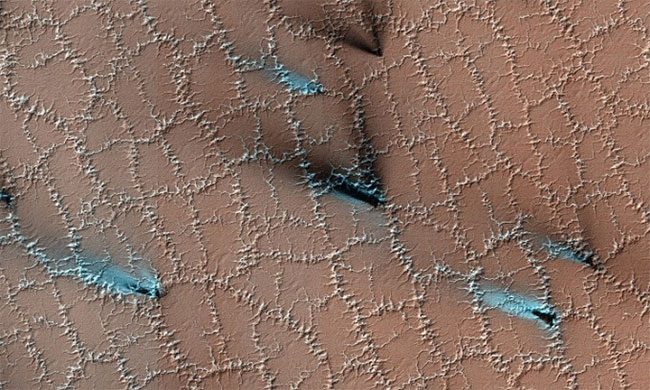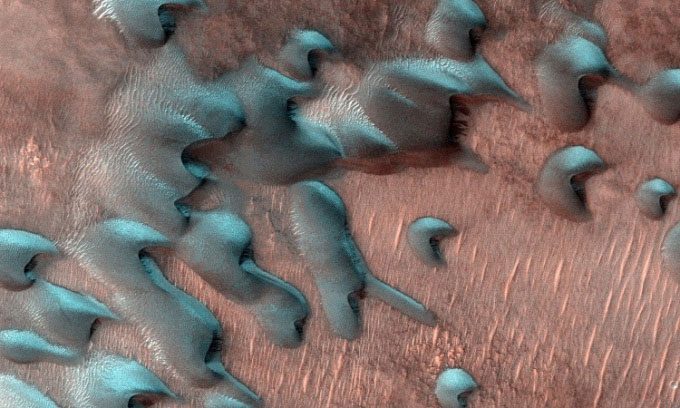Mars can experience winter temperatures as low as -123 degrees Celsius, with two types of snow featuring square snowflakes and many unusual shapes on the surface when the ice melts.
When winter arrives on Mars, the planet’s surface transforms into a different world. Accompanying sub-zero temperatures are ice, snow, and frost. Some of the coldest regions are located at the planet’s poles, where temperatures can drop to -123 degrees Celsius. However, no area on Mars has snowfall thicker than a few meters. The planet’s elliptical orbit means that winter lasts for many months. One Martian year is approximately equivalent to two Earth years. Nevertheless, the planet has many unique phenomena during winter that scientists can study, thanks to NASA’s exploratory robots.

Water ice divides the land into many beautiful polygonal shapes. (Photo: NASA).
Two Types of Snow
Mars has two forms of snow: water ice and carbon dioxide, also known as dry ice. Due to the thin atmosphere of Mars and extremely cold temperatures, snow formed from water ice sublimates, turning into gas before it even reaches the ground. Snow from dry ice, however, actually lands on the surface. “However, if you’re looking for a place to ski, you’ll need to head to a crater or cliff”, where snow accumulates on the sloped surface,” said Sylvain Piqueux, a Mars researcher at NASA’s Jet Propulsion Laboratory in Southern California.
How NASA Detects Snowfall
Snow only appears during the coldest times on Mars, including at the poles, under cloud cover, and at night. Cameras on orbiting spacecraft cannot see through clouds, and ground missions cannot survive in the extreme cold temperatures. As a result, there are no pictures of snow falling. However, scientists know it occurs thanks to several specialized instruments.
The NASA Mars Reconnaissance Orbiter can see through cloud cover using its Mars Climate Sounder, which detects light at wavelengths that the human eye cannot see. This ability allows scientists to detect falling carbon dioxide snow. In 2008, NASA sent the Phoenix lander to about 1,600 kilometers from Mars’ northern pole. There, Phoenix used a laser device to detect falling water-ice snow.
Square Snowflakes
Due to the way water molecules bond when freezing, snowflakes on Earth have six sides. The same principle applies to all crystals. The arrangement of atoms determines the shape of the crystal. In the case of carbon dioxide, molecules in dry ice always bond in a four-sided shape when frozen. “Because dry ice has a four-faced symmetrical shape, we know that snowflakes formed from this type of ice will be square,” Piqueux said. “Thanks to the Mars Climate Sounder, we can determine that the snowflakes will be smaller than the width of a human hair.”
Frost on Mars

Frost covers the colder side facing north of a sand dune on Mars. (Photo: NASA).
Both water and carbon dioxide can form frost on Mars. Both types of frost appear on the planet over a much wider range than snow. The Viking lander encountered frost while studying Mars in the 1970s. NASA’s Odyssey orbiter has observed frost forming and melting under the morning sunlight.
The End of Winter
The most interesting discovery likely occurs at the end of winter when all accumulated ice begins to melt and evaporate into the atmosphere. During this process, the melting ice creates many strange and beautiful shapes reminiscent of spider webs, fried eggs, and Swiss cheese. The melting process also causes many geysers to erupt. The transparent ice allows sunlight to heat the gas beneath. When the gas explodes, layers of dust are ejected onto the surface. Scientists are beginning to study this layer of dust to understand how the wind blows on Mars.


















































